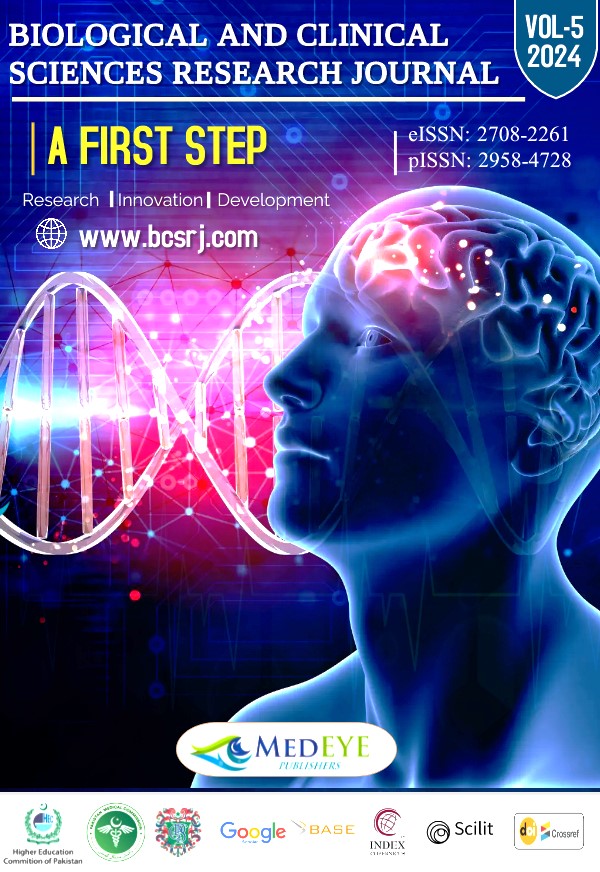COMPARING THE EFFICACY OF 35% TRICHLOROACETIC ACID (TCA) PEEL WITH TOPICAL 0.1% ADAPALENE GEL IN THE TREATMENT OF COMEDONAL ACNE
DOI:
https://doi.org/10.54112/bcsrj.v2024i1.1436Keywords:
Comedonal acne, Trichloroacetic acid peel, Adapalene gel, Chemical peel, Topical retinoid.Abstract
Comedonal acne is a common dermatological condition characterized by open and closed comedones. Treatment modalities, including chemical peels and topical retinoids, have managed comedonal acne. Aim and Objective: This study aimed to compare the efficacy of 35% trichloroacetic acid (TCA) peel with topical 0.1% adapalene gel in treating comedonal acne. Methodology: A randomized controlled trial (RCT) was conducted at the Sheikh Zayed Hospital, Rahim Yar Khan. A total of 80 patients with comedonal acne were recruited and randomly assigned to two treatment groups: Group A received 35% TCA peel, while Group B received topical 0.1% adapalene gel. The primary outcome measures included changes in comedonal lesion count and severity, assessed using standardized clinical photographs and dermatological examinations. Secondary outcomes comprised patient-reported improvement, adverse events, and treatment tolerability. Results: The mean age of participants was 25.4 ± 4.6 years, with a female predominance (65%). At baseline, both groups exhibited similar comedonal lesion counts and severity scores. Following treatment, a significant reduction in comedonal lesions was observed in both groups (p < 0.001). However, the reduction in comedonal lesion count was more significant in the 35% TCA peel group than the adapalene gel group (mean decrease of 80% vs. 60%, respectively). Additionally, patients in the TCA peel group reported higher satisfaction rates and fewer adverse events than the adapalene gel group. Conclusion: Our study suggests that 35% TCA peel is more effective than topical 0.1% adapalene gel in reducing comedonal acne lesions and improving patient satisfaction. TCA peel may represent a promising treatment option for patients with comedonal acne, offering superior efficacy and tolerability compared to topical retinoids.
Downloads
References
Stamu‐O'Brien C, Jafferany M, Carniciu S, Abdelmaksoud A. Psychodermatology of acne: psychological aspects and effects of acne vulgaris. Journal of cosmetic dermatology. 2021;20(4):1080-3.
Mustafa SAG. An Overview About Acne Vulgaris. Journal of Pharmaceutical Negative Results. 2022:4395-402.
Nwabudike LC. Individualised homeopathic treatment of acne—An analysis of 83 patients. Homeopathy. 2021;110(04):271-6.
Eichenfield DZ, Sprague J, Eichenfield LF. Management of acne vulgaris: a review. Jama. 2021;326(20):2055-67.
S. Sitohang IB, Legiawati L, Suseno LS, Safira FD. Trichloroacetic acid peeling for treating photoaging: a systematic review. Dermatology research and practice. 2021;2021(1):3085670.
Măgerușan ȘE, Hancu G, Rusu A. A Comprehensive Bibliographic Review Concerning the Efficacy of Organic Acids for Chemical Peels Treating Acne Vulgaris. Molecules. 2023;28(20):7219.
Surprenant D, Reserva J, Tung R. Combination Therapy in Acne: Peels as Adjuvant Therapy. Procedures in Cosmetic Dermatology Series: Chemical Peels. 2020:125.
Sarkar R, Arsiwala S, Dubey N, Sonthalia S, Das A, Arya L, et al. Chemical peels in melasma: A review with consensus recommendations by Indian pigmentary expert group. Indian journal of dermatology. 2017;62(6):578-84.
Thiboutot DM, Dréno B, Abanmi A, Alexis AF, Araviiskaia E, Cabal MIB, et al. Practical management of acne for clinicians: An international consensus from the Global Alliance to Improve Outcomes in Acne. Journal of the American Academy of Dermatology. 2018;78(2):S1-S23. e1.
Wan J, Takeshita J, Shin DB, Gelfand JM. Mental health impairment among children with atopic dermatitis: a United States population-based cross-sectional study of the 2013-2017 National Health Interview Survey. Journal of the American Academy of Dermatology. 2020;82(6):1368-75.
Stein Gold L, Weiss J, Rueda MJ, Liu H, Tanghetti E. Moderate and severe inflammatory acne vulgaris effectively treated with single-agent therapy by a new fixed-dose combination adapalene 0.3%/benzoyl peroxide 2.5% gel: a randomized, double-blind, parallel-group, controlled study. American journal of clinical dermatology. 2016;17:293-303.
Van Zuuren E, Arents B, Miklas M, Schoones J, Tan J. Identifying and appraising patient‐reported outcome measures on treatment satisfaction in acne: a systematic review. British Journal of Dermatology. 2021;185(1):36-51.
Megna M, Cirillo T, Balato A, Balato N, Gallo L. Real‐life effectiveness of biological drugs on psoriatic difficult‐to‐treat body regions: scalp, palmoplantar area and lower limbs. Journal of the European Academy of Dermatology and Venereology. 2019;33(1):e22-e3.
Mangan MS. Direct corneal injury during radiofrequency-assisted upper blepharoplasty. Dermatologic Surgery. 2021;47(8):1146-7.
Kessler E, Flanagan K, Chia C, Rogers C, Glaser DA. Comparison of α-and β-hydroxy acid chemical peels in the treatment of mild to moderately severe facial acne vulgaris. Dermatologic surgery. 2008;34(1):45-51
Downloads
Published
How to Cite
Issue
Section
License
Copyright (c) 2024 N RANI , T HASSAN , MK SHAHZAD , N HANIF , M ULLAH , F HUMERA

This work is licensed under a Creative Commons Attribution-NonCommercial 4.0 International License.








